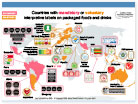A study published today in PLOS ONE found that for Colombian adults, nutrient warning labels work better than two other common front-of-package (FOP) label types for discouraging consumption of ultra-processed foods.
The experiment
Researchers at Universidad Nacional de Colombia, Pontificia Universidad Javeriana, and UNC-Chapel Hill conducted a study involving over 8,000 Colombian adults. In this experiment, each participant was randomly assigned to one of four FOP label conditions:
- An octagonal, stop sign nutrient warning label (below, left);
- the industry-preferred voluntary Guideline Daily Amounts (GDA) label (below, center);
- A color-coded Nutri-Score label used voluntarily in a handful of European countries (below, right); or
- No FOP label (control condition).

Participants were asked to compare two fruit drinks with labels from their assigned group. One of the fruit drinks was healthier (contained naturally occurring and no added sugar), and one of the fruit drinks was less healthy (contained 39.4 grams of sugar and included added sugar). They were asked to pick the healthier product, choose which drink they thought was higher in sugar, and indicate which one they would rather buy.
Next, participants answered questions about other products (yogurt, cookies, sliced bread, and breakfast cereal) to see if they could correctly pick which ones were high in a nutrient of concern (e.g., sugar, saturated fat) and whether FOP labels discouraged them from wanting to consume the product. Finally, participants viewed all three label types and picked which one would discourage them most from wanting to consume the product.
Findings
Of the FOP label types tested, nutrient warning labels were most effective in each of these outcomes:
- Participants who correctly identified products with excess sugar, saturated fat, or sodium:
- Nutrient warning labels: 75%
- GDA label: 43%
- Nutri-Score label: 26%
- No label: 23%.
- Participants who felt discouraged from consuming a product high in sugar, saturated fat, or sodium:
- Nutrient warning labels: 72%
- GDA label: 20%
- Nutri-Score label: 9%.
- Participants who chose the less healthy of two fruit drinks as the one they wanted to consume:
- Nutri-Score: 33%
- No label: 29%
- GDA label: 24%
- Nutrient warning label: 20%
The impact of the warning label on product selection was similar across education levels. This provides evidence that nutrient warning labels would not lead to increased disparities in product selection by education level.
This study builds on the team’s previous study published October, 2020 in Nutrients, which found that a “stop sign,” octagonal nutrient warning label (like those implemented in Chile, Peru, and Mexico) was more effective than a circular or triangular nutrient warning label at discouraging Colombian adults from wanting to buy ultra-processed products.
Importance
In July 2021, the Colombian government passed a new law — Ley Comida Chatarra (The Junk Food Law) — which has legislated mandatory front of package labeling for Colombia. Implementation of the junk food law must take place within one year of passage, and the regulatory norms, including final label design, are forthcoming. This study supports implementation of octagonal nutrient warning labels as the new mandatory FOP label in Colombia.
Funding support for this study was provided by Bloomberg Philanthropies. Additional support for some authors was provided by the National Institutes of Health.
AUTHORS:
Mercedes Mora-Plazas
Isabella C. A. Higgins
Luis Fernando Gomez
Marissa G. Hall
Maria Fernanda Parra
Maxime Bercholz
Nandita Murukutla
Lindsey Smith Taillie
RESOURCES:
Learn more about the evidence for front-of-package nutrient labels in our fact sheet.
View FOP label policies around the world in our front-of-package labeling policy maps.

